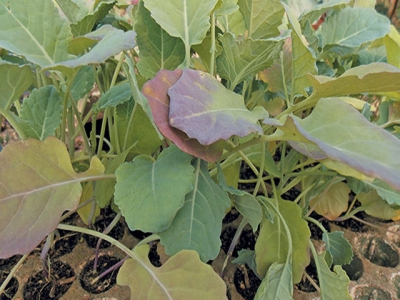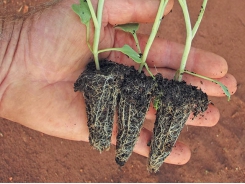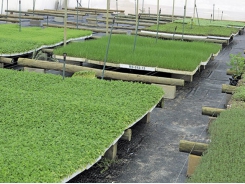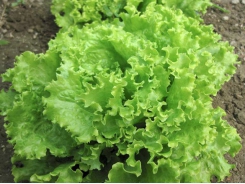Hardening vegetable seedlings

A Highveld farmer I knew once desperately needed seedlings and turned to a supplier in another region. I still recall his shock when the consignment arrived: the seedlings were far larger and harder than he was used to.
A seedling producer can harden seedlings by withholding nitrogen, as was done here. The plants are effectively in limbo. They can be reactivated with a dose of nitrogen before being sold to the farmer. Photo: Bill Kerr
I still recall his shock when the consignment arrived: the seedlings were far larger and harder than he was used to. He asked me whether they were any good, and I assured him there was nothing wrong with them.
They had simply been grown in a subtropical climate and had to be bigger in order to survive in this harsher environment. Seedlings grown on the Highveld for Highveld conditions tend to look considerably different.
There is often confusion over what comprises a ‘good’ seedling. Survival is the first priority, and a fast getaway is the second. The rule of thumb is to have a seedling as soft and actively growing as possible while still being able to secure a full stand without stressing the plants.
An active, young plant will survive after planting, but only with difficulty if the conditions it is planted in are very different from the conditions in the nursery. Too great a difference will shock the plant, and it will slow down its growth and harden itself to cope. If any hardening is required, it should be done in the nursery, not on the land.
Hardening can be accomplished in a number of ways. To understand these better, we need to know a bit about plant physiology. A plant is ‘wired’ to grow as fast as possible; if it cannot compete with other species, it will not survive to produce seed.
In addition, a plant must adapt to unfavourable conditions by hardening its cell walls and storing energy derived through photosynthesis rather than using it immediately. The stored energy is used for rapid growth when conditions return to normal. In some cases, such as drought, the plant may extend its root system rather than use the energy for rapid growth.
Solution one: withhold water
Taking all these factors into account, it is clear that one way to harden plants is to withhold water in order to induce drought stress. This is easier said than done, however.
To begin with, the irrigation must be uniform. If it is not, some plants will be under the required stress, while others will continue to grow vigorously.
Also, if the plants are not under cover, rain can undo all a farmer’s efforts and stimulate the plants into vigorous growth.
Solution two: slow down growth
A more practical way to stress plants into hardness is to retard growth when they reach transplant size by withholding nitrogen. This is possible in all growing and climatic conditions. The plants go into limbo and the cells harden without ill effect.
The seedling producer should then provide a generous dose of nitrogen a few days before the seedlings are despatched to the farmer. In this way, the process of recovery will have commenced but not to the extent of reversing the hardness. This is done by the farmer as described in a previous column.
Related news
Tools

Phối trộn thức ăn chăn nuôi

Pha dung dịch thủy canh

Định mức cho tôm ăn

Phối trộn phân bón NPK

Xác định tỷ lệ tôm sống

Chuyển đổi đơn vị phân bón

Xác định công suất sục khí

Chuyển đổi đơn vị tôm

Tính diện tích nhà kính

Tính thể tích ao




 Seedlings and seedling trays
Seedlings and seedling trays  How to deal with big-vein virus and tipburn…
How to deal with big-vein virus and tipburn…